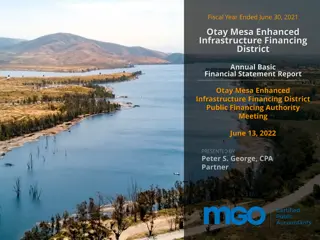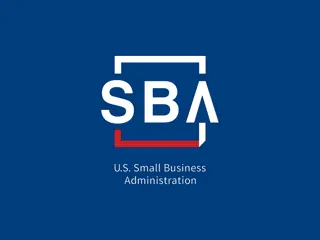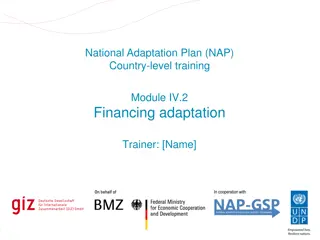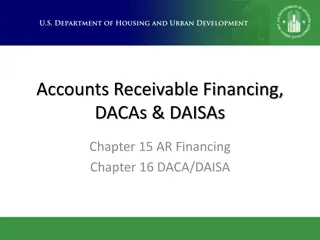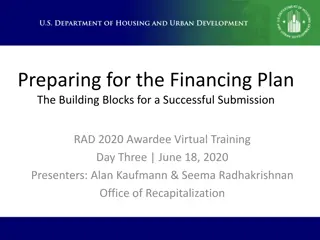
College Financing Guide: How to Pay for Education at Hood College
Explore the process of financing college education presented by Hood College's Financial Aid Office. Learn about financial aid, the FAFSA application, common errors to avoid, correcting information, and receiving your Student Aid Report. Find out how to create an award package and understand your Expected Family Contribution. Download the myStudentAid mobile app for assistance in managing your financial aid journey.
Uploaded on | 0 Views
Download Presentation

Please find below an Image/Link to download the presentation.
The content on the website is provided AS IS for your information and personal use only. It may not be sold, licensed, or shared on other websites without obtaining consent from the author. If you encounter any issues during the download, it is possible that the publisher has removed the file from their server.
You are allowed to download the files provided on this website for personal or commercial use, subject to the condition that they are used lawfully. All files are the property of their respective owners.
The content on the website is provided AS IS for your information and personal use only. It may not be sold, licensed, or shared on other websites without obtaining consent from the author.
E N D
Presentation Transcript
How to pay for college Financing Education Presented by Hood College Financial Aid Office
What is Financial Aid? Financial aid consists of all funds provided to students and families to help pay for postsecondary educational expenses
Its all about the FAFSA Free Application for Federal Student Aid Free Application for Federal Student Aid A standard form that collects demographic and financial information about the student and family Filed online at https://studentaid.gov Required for all Federal Aid and some states aid myStudentAid App
Step 1 Obtain FSA ID (Federal Student Aid Password/Signature) at: https://FSAID.ed.gov Each student needs their own FSA ID At least one parent needs their own FSA ID 2 step authentication-use smart phone and computer
Step 2 Fill out all parts of the FAFSA (make sure to answer all questions and when asked, put a zero (0) in for dollar amounts You may start filling out the FAFSA October 1 October 1, 2020 for 2021-2022 use 2019 taxes October 1, 2021 for 2022-2023 use 2020 taxes IRS Data Retrieval Tool (DRT)-IRS Information links with the FAFSA
Frequent FAFSA Errors Social Security Numbers Divorced/widowed/remarried parental information Income earned by parents/stepparents Untaxed income U.S. income taxes paid Household size Number of household members in college Real estate and investment net worth
More steps Step 4 Make corrections if needed Step 3 Receive your Student Aid Report (SAR) via email from the federal processor, summarizing the data provided on the FAFSA. Send all requested documents to the College/University your student has chosen The SAR will include your Expected Family Contribution (EFC). This will be the same number/calculation for all schools. An award Package will now be created for your student by the Financial Aid offices EFC is an index used to determine government and institutional funds. This is not always an accurate picture of what you can afford. Mobile App now available!
After the student signs, then the parent information will be completed and signed for.
Financial Aid Terms to Know EFC Budget/Costs Award Package SAP-Standards of Academic Progress Dependency Status Verification Need CSS Profile
What is Expected Family Contribution (EFC)? Stays the same regardless of college Two components Parent contribution Student contribution Calculated using data from a federal application form and a federal formula
Budget/ What is Cost of Attendance (COA)? There are 5 categories Tuition and Fees Room and meal plan Books and Supplies Transportation Personal Expenses Direct costs Indirect costs The total of these categories equals the COA. The COA less EFC equals need. Need is used to determine your financial award and will vary from college to college.
Award Package All awarded funds from a college. Types include: Merit Aid Federal Aid State Aid Other institutional aid Outside scholarships
Satisfactory Academic Progress Satisfactory Academic Progress (SAP) is required by all institutions. Students must maintain a certain GPA in order to keep their financial aid and they must have a cumulative 67% passing rate. The GPA for institutional aid (merit awards) may be different from the federal requirements. Please check with the school you will be attending.
Dependent/Independent Students Dependent students must include parental information on the FAFSA. Dependent Students are students who cannot answer yes to one of the following: Student is at least 24 years old Student is a graduate or professional student Student is married Student is supporting children Student is an orphan or ward of court Student is a veteran of the U.S. Armed Forces
Verification 30% to 35% of all FAFSA filers are selected Some schools verify 100% of filers You may link your taxes to your FAFSA (DRT) Documents that may be requested to verify information on the FAFSA Tax transcripts for parents and students Verification worksheet Maybe W-2 s Parents and Students
CSS Profile Some colleges use this to determine institutional funds The cost is $25 $16 for each additional school Very detailed financial information Not all schools use all questions
Types of Government Aid Free Money Loans-Student Loans-Parent Work Study
Who is Eligible for Federal Student Aid? U.S. citizen or permanent resident High school graduate/GED holder Eligible degree/certificate program Valid Social Security number Males registered for Selective Service Satisfactory academic progress in college/career school
Federal aid break down Pell Grant-Max is $6395 20-21 FSEOG-to students who qualify for the Pell Grant Direct Student Loans-All students, repayment 6 months after student leaves school with a 10 year repayment (other options available) Subsidized - Government subsidizes the interest Unsubsidized - Student pays the interest Parent Plus Loan- credit check is done by Federal Government, and repayment may begin after second disbursement.Loan maybe deferred while student is in school Federal Work-Study- paid for based on hours worked
State Aid (Maryland Programs) Senator Delegate Guaranteed Access Grant Educational Assistance Grant Contact Senator / Delegate Determined by FAFSA Deadline is March 1, FAFSA required and include at least one MD School Applications at https://MHEC.state.md.us Student must log in and accept award at https://MDCAPS.mhec.state.md.us
Additional Aid What is it? Where to find it? How to obtain it? What about VA Benefits?
Institutional Aid Merit aid-funds awarded to students based on grades, extra- curricular activities, and information found on the college application. These amounts are awarded through the admission office. Need based-funds are awarded by the Office of Financial Aid Other institutional funds may be awarded, however a separate application maybe required. Frequently these funds are endowed and have certain requirements with them.
VA Benefits Federal: Student needs to obtain a Certificate of Eligibility from the Veterans Affairs office If the student is the Veteran may need DD-214 This is for all Post 9/11 benefits Colmery Forever GI Bill https://www.benefits.va.gov https://www.vets.gov State: Edward T. & Mary A. Conroy Memorial Scholarship Program and Jean B. Cryor Memorial Scholarship Program Veterans of the Afghanistan and Iraq Conflicts Scholarship Program
Other Funding Options Scholarships and Grants Civic Scholarships and Grant Trusted Scholarship Search Engines Employer assistance Private loans Loans from alternative/private sources Mortgage Refinance or pay out mortgage Retirements Accounts/Loans-401K
Self-Help Aid Other Loans Private Education Loans Also known as supplemental or alternative loans Borrowed by the student or parent Interest begins accruing at disbursement to the school Banks and other lending institutions are the source of the funds Credit-based PROCESS may vary but most are similar Borrower s (and co-signer s) credit will be checked to determine eligibility Application through disbursement may take time, so begin early (usually before August) Compare/shop, and determine what is best for the student and family
Planning ahead Students need to remember to account for EVERY year that they will be in school (not just the first year), including graduate/professional school Begin saving at ANY time before college, including summers Prepare a budget to take into account costs for 4+ years of school Review school cost of attendance information Be creative; consider all possible ways to fund, including school payment plans to help reduce debt
Outside Scholarships and Grants Civic Organizations Check with your high school counselors Varying amounts, due dates, criteria https://fastweb.com https://myscholly.com www.scholarship.com www.central-scholarship.org www.gocollege.com www.cffredco.org https://collegeboard.org www.cfwcmd.org
Helpful Web Sites: https://studentaid.gov https://FSAID.ed.gov www.mhec.state.md.us www.hood.edu https://studentloans.gov https://sss.gov https://www.nasfaa.org/State_Financial_Aid_Programs
The Office of Financial Aid Contact information Finaid@hood.edu 301-696-3411 Today s presentation can be found at: www.hood.edu/finaidpresentation Questions?????






